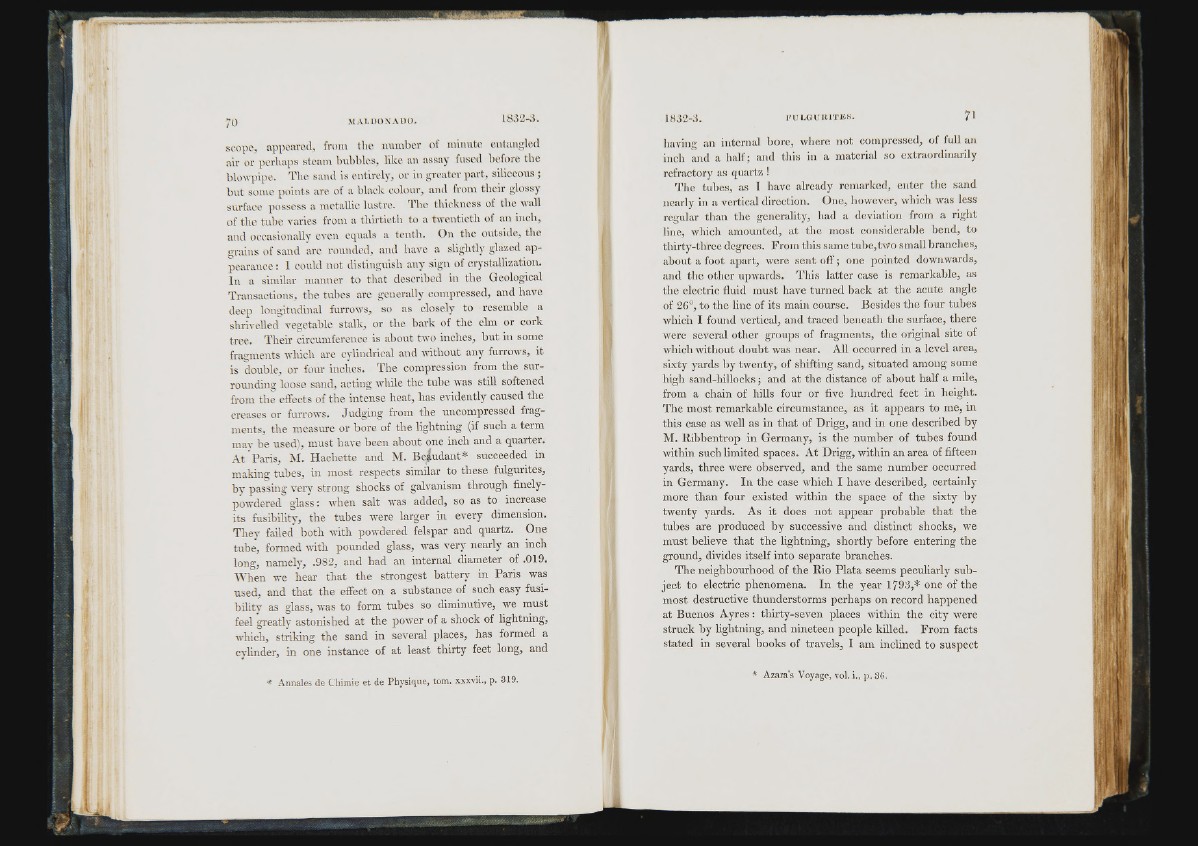
70 MALDOXADO. IS 3 2 - 3 .
scope, appoaiTd, from the luimbcr of minute entangled
air or perhaps steam bubbles, like an assay fused before the
blowpipe. The sand is entirely, or in greater part, siliceous;
but some points are of a black colour, and trom their glossy
surface possess a metallic lustre. The tluckuess of the wall
of the tube varies from a thirtieth to a twentieth of an inch,
and oeeasionallv even equals a tenth. On the outside, the
grains of sand are rounded, and have a slightly glazed appearance
: 1 could not distinguish any sign of crystffilizatiou.
In a similar manner to that described in the Geological
Transactions, the tubes are generally compressed, and have
deep longitudinal furrows, so as closely to resemble a
shrivelled vegetable stalk, or the bark of the elm or cork
tree. Their circumference is about two inches, but in some
fragments which are cylindrical and without any furrows, it
is double, or four inches. The compression from the surrounding
loose sand, acting while the tube was still softened
from the effects of the intense heat, has evidently caused the
creases or furrows. Judging from the uncompressed fragments,
the measure or bore of the lightning (if such a term
mav be used), must have been about one inch and a quarter.
At Paris, M. Hachette and M. Be|udant* succeeded in
making tubes, in most respects similar to these fulgurites,
by passing very strong shocks of galvanism through finely-
powdered glass: when salt was added, so as to increase
its fusibility, the tubes were larger in every dimension.
They failed both with powdered felspar and quartz. One
tube’, formed with pounded glass, was very nearly an inch
long, namely, .982, and had an internal diameter of .019.
IVhen we hear that the strongest battery in Paris was
used, and that the effect on a substance of such easy fusi-
bfiity as glass, was to form tubes so diminutive, we must
feel greatly astonished at the power of a shock of lightning,
which, striking the sand in several places, has formed a
cylinder, in one instance of at least thirty feet long, and
# A n n a le s d e C h im ie e t d e P h y s iq u e , tom . x x x v ii., p. 3 19.
1H3 2 - 3 . 7 1
having an internal bore, where not compressed, of full an
inch and a half; and this in a material so extraordinarily
refractory as quartz I
J'he tidies, as I have already remarked, enter the sand
nearly in a vertical direction. One, however, which was less
regular than the generality, had a deviation from a right
line, wliieli amounted, at tlic most considcralile bend, to
tliirty-tiirce degrees. From tliis same tube,two small liranches,
about a foot apart, were sent o ff; one pointed downwards,
and tlie other upwards. This latter case is remarkable, as
the electric fluid must have turned back at the acute angle
of 26°, to the line of its main course. Besides the four tubes
whicii I found vertical, and traced beneath the surface, there
were several other groups of fragments, the original site of
which without doubt was near. All occurred in a level area,
sixty yards by twenty, of shifting sand, situated among some
high sand-hillocks; and at the distance of about half a mile,
from a chain of hills four or five hundred feet in height.
The most remarkable circumstance, as it appears to me, in
this case as w'ell as in that of Drigg, and in one described by
M. liibbentrop in Germany, is the number of tubes found
within such limited spaces. At Drigg, within an area of fifteen
yards, three were observed, and the same number occurred
in Germany. In the case which I have described, certainly
more than four existed within the space of the sixty by
twenty yards. As it does not appear probable that the
tubes are produced by successive and distinct shocks, we
must believe that the lightning, shortly before entering the
ground, divides itself into separate branches.
The neighbourhood of the Rio Plata seems peculiarly subject
to electric phenomena. In the year 1793,* one of the
most destructive thunderstorms perhaps on record happened
at Buenos Ayres: thirty-seven places within the city were
struck by lightning, and nineteen people killed. From facts
stated in several books of travels, I am inclined to suspect
* A z iira ’s Vo y ag e, vo l. i,, p . 36.
i l l